My last blog covered the Guernsey Literary Festival, so I’ll just add that we had some wonderful 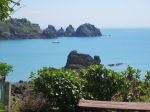 walks when we were not at events. Here’s a picture of the scene before us as we ate our lunch one day.
walks when we were not at events. Here’s a picture of the scene before us as we ate our lunch one day.
I had rather expected to find the Channel Islands swarming with tax-evaders; but I’m pleased to say that, in my limited experience, that wasn’t the case. There were some gas-guzzling cars and certainly some quite vulgar large plush boats, but the people we met were perfectly normal, and most of the houses were quite modest. There were some beautiful sailing boats, but the rocks that surround the islands like sharp teeth were enough to persuade me that there are other waters in which I’d rather sail.
One small, rather sweet, peculiarity of the islands is that the post boxes are blue instead of red. Many of the road names are still in Norman French, which used to be the patois of the islands; but apart from that there didn’t seem to be a great deal of French influence, despite the sizeable number of French visitors. The only two less than perfect aspects of the whole holiday were 1. Channel Island coffee and 2. the fact that I was sea sick on the fast cat bumping over the Atlantic swell for an hour and a half on the way from Alderney to Guernsey at the end.
After the Guernsey Literary Festival, we took off to explore the smaller islands. This blog is to share my personal reactions to Herm, Sark and Alderney, which I’ll describe in the opposite order to our visits, so that I can end up with what, for me, was the best.
Alderney is further from Guernsey than the other two and is, in fact, within sight of France. It is 3 miles x 1.5 miles and has a population that has recently dropped from 2,000 to about 1,900, most of whom live in the only town, St Anne.
 The boat in which we should have travelled from Sark to Alderney turned out, to our surprise, to be out of the water, so we had to take a ferry back to Guernsey and then fly to Alderney. As we approached the island we flew over two rocky outcrops which appeared to be covered in snow. This is one of the largest gannet colonies, hom
The boat in which we should have travelled from Sark to Alderney turned out, to our surprise, to be out of the water, so we had to take a ferry back to Guernsey and then fly to Alderney. As we approached the island we flew over two rocky outcrops which appeared to be covered in snow. This is one of the largest gannet colonies, hom e to about 2% of the world’s population of gannets. The next day we walked out to the cliffs just above the gannetry, and lay in the sun, surrounded by sea pinks, as we watched the endless comings and goings of the birds (well, clearly some watched more than others!)
e to about 2% of the world’s population of gannets. The next day we walked out to the cliffs just above the gannetry, and lay in the sun, surrounded by sea pinks, as we watched the endless comings and goings of the birds (well, clearly some watched more than others!)
We were delighted to discover that we had arrived just as the Alderney Performing Arts Festival weekend began. On the first evening we went to a performance by the Bowjangles: a professional string quartet of comedians, who both play exquisitely and also fool around and raise laughs. It’s one thing to watch someone with a violin leaping on and off chairs, playing imaginary tennis with the instrument or using it as a weapon; it’s another when the instrument is a ‘cello. The ‘cellist had a small lump on the neck of her instrument that slotted behind her own neck, thus enabling her to dance and cavort without dropping her instrument.

The following morning the festival was moved up a key – or rather several decibels – with a procession of Samba drummers through the town. Then that evening we walked out to Essex Castle for a beautiful performance for harp and singer-dancer of Christina Rossetti’s ‘Goblin Market’, followed by supper. The harpist was Elizabeth-Jane Baldry from Devon, and the singer-dancer was Maxine Fone, who had me completely mesmerised throughout her performance.
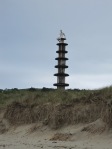
Down on the beach near the harbour there is a temporary sculpture, known as the Alderney Man, created by the sculptor from Bath, Anna Gillespie. Unfortunately, I believe that this will be removed later in the summer.
Alderney was evacuated during WWII, and therefore completely taken over by the Nazis. It is impossible to forget this sad history, as the whole island is bristling with military installations – some of which, in fact, pre-date the war by several centuries.
The best aspects of Alderney were the coast path, the butterflies, the birdsong and the cobbled streets (strictly sets not cobbles). There are said to be blond hedgehogs on Alderney, but the only hedgehog I saw had been squashed by a car so it was impossible to tell what colour it had been. I did however learn than baby hedgehogs are called hedgehoglets.
On the negative side, the island, and certainly the town, is ruined by too many cars driven by atrocious drivers. The pavements are very narrow, and drivers think nothing of parking their cars on them. Given the tiny size of the island it is crazy that such unnecessary traffic has been allowed to proliferate to this extent. The inhabitants of the island appeared to be more insular than on Herm and Sark, and the level of cuisine was lower than I had expected from somewhere so close to France.
Sark. Our time in Sark was cut short because the boat we had booked turned out not to be in operation. However, we spent a couple of pleasant days walking, ‘cycling and visiting  some friends (poetry again!)
some friends (poetry again!)
There are two islands: the main Sark, and Little Sark which is connected to the main island by a high ridge called La Coupée, on which prisoners of war built a narrow (and rather high) path.
Sark is about 4.5 square miles, the population is a mere 600, and most people travel everywhere by bicycle, so it is great for walking and ‘cycling. Tractors are allowed on the roads, for transporting goods and people, and as is the way with such things, the number of these has increased exponentially. There are also horse-drawn carriages, but these are not suitable for the steep climb up from the harbour to the ‘town’. The town itself has wide, car-free dust roads and clapper board houses, which together give it something of an air of the Wild West.
The island forms part of the Bailiwick of Guernsey, but is self-governing. The strange, and rather archaic, political system is further complicated by the presence on the nearby island of the Barclay Brothers, who have tried to influence events and development on Sark and are consequently not universally popular. The politics of this tiny island would, however, need a whole blog to expound, so I’ll pass over the detail and just say that La Seigneurie Gardens, attached to what used to be the residence of the Seigneur, are beautiful.

One of the changes wrought by the Barclay brothers is the introduction of vineyards, of which there are now probably half a dozen, all of which seem to have taken well. These, too, are not generally liked, and there is scepticism about whether they will produce good enough grapes for wine; but some project leading to export would seem to be of potential benefit.
Sark has been awarded a Dark Skies status, so the nights were truly black and star-lit. The island lacks the beautiful beaches of Herm, or even Alderney, but the cliffs are fairly spectacular. There is only one postbox on Sark, and this was painted gold, in honour of the dressage Olympian,  Carl Hester, who was born on the island (though I believe it is many years since he has lived there).
Carl Hester, who was born on the island (though I believe it is many years since he has lived there).
One of the highlights of our visit to Sark was, I must admit, the opportunity to have lobster for dinner two nights running, without breaking the bank.
Herm

Herm was, without doubt, my favourite island. It claims for itself the title of ‘Paradise Island’, and the nomenclature is not entirely inappropriate.
 We had secured a special out-of-season deal at the gorgeous White House Hotel, and were thoroughly spoilt for two glorious, ultra-relaxing days.
We had secured a special out-of-season deal at the gorgeous White House Hotel, and were thoroughly spoilt for two glorious, ultra-relaxing days.
I think we covered every inch of the tiny island several times, which is hardly surprising as it measures a mile and a half by half a mile. There are no cars or bicycles on the island; but both round the coast and crisscrossing the interior are excellent footpaths. I believe that in summer the island does fill up, but with a population of 60, at this time of year it is extremely peaceful.


There are beautiful beaches (and the hardier member of the family did actually indulge in one sea swim – while I saved myself for the pleasant hotel pool), and the whole island is covered in flowers.
At the north end, where the land is moor-like, the burnet roses were growing like daisies, and the daisies like grass.

If I ever get the chance to visit Herm again, I shall jump at it. The food was great and the staff were all friendly and relaxed, Our bedroom had a large balcony and looked out over the sea, where I could have sat dreaming in the sun for hours if we hadn’t been enjoying the walking so much. It would make a wonderful place to write, but I’m afraid that treat would be reserved for someone who had produced several best-sellers and could afford the luxury. I just count myself lucky that I was able to enjoy two such perfect days there.

When we returned to Guernsey at the end of our holiday, we caught a ‘bus up to the Fresia Centre, where flowers are cut throughout the year and sent far and wide.
This was a really enjoyable and relaxing holiday. I hope I’ve been able to convey some of the experience to you in this blog.
 ‘Love Bomb’, by Marc Quinn, was the first installation we saw as we arrived at Jupiter. Twelve metres tall and resembling an exotic totem pole, it’s set on a small hill and can be seen from quite a distance.
‘Love Bomb’, by Marc Quinn, was the first installation we saw as we arrived at Jupiter. Twelve metres tall and resembling an exotic totem pole, it’s set on a small hill and can be seen from quite a distance.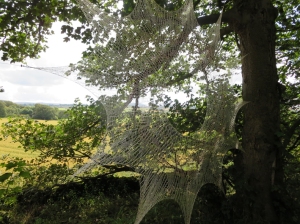

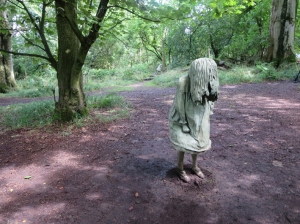 These were carved from wax and cast in various ‘found objects’ at the foundry.
These were carved from wax and cast in various ‘found objects’ at the foundry.
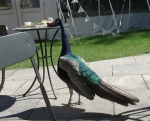 appreciate the facilities. As we were sitting outside in the sun and out of the wind, we were plagued by wasps until we persuaded one of the staff to provide a jam jar trap.
appreciate the facilities. As we were sitting outside in the sun and out of the wind, we were plagued by wasps until we persuaded one of the staff to provide a jam jar trap.





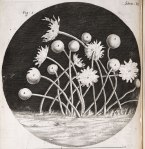
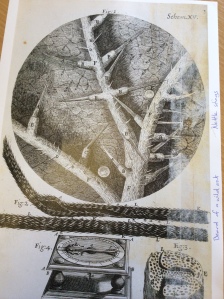

 walks when we were not at events. Here’s a picture of the scene before us as we ate our lunch one day.
walks when we were not at events. Here’s a picture of the scene before us as we ate our lunch one day. The boat in which we should have travelled from Sark to Alderney turned out, to our surprise, to be out of the water, so we had to take a ferry back to Guernsey and then fly to Alderney. As we approached the island we flew over two rocky outcrops which appeared to be covered in snow. This is one of the largest gannet colonies, hom
The boat in which we should have travelled from Sark to Alderney turned out, to our surprise, to be out of the water, so we had to take a ferry back to Guernsey and then fly to Alderney. As we approached the island we flew over two rocky outcrops which appeared to be covered in snow. This is one of the largest gannet colonies, hom e to about 2% of the world’s population of gannets. The next day we walked out to the cliffs just above the gannetry, and lay in the sun, surrounded by sea pinks, as we watched the endless comings and goings of the birds (well, clearly some watched more than others!)
e to about 2% of the world’s population of gannets. The next day we walked out to the cliffs just above the gannetry, and lay in the sun, surrounded by sea pinks, as we watched the endless comings and goings of the birds (well, clearly some watched more than others!)

 some friends (poetry again!)
some friends (poetry again!)


 We had secured a special out-of-season deal at the gorgeous White House Hotel, and were thoroughly spoilt for two glorious, ultra-relaxing days.
We had secured a special out-of-season deal at the gorgeous White House Hotel, and were thoroughly spoilt for two glorious, ultra-relaxing days.








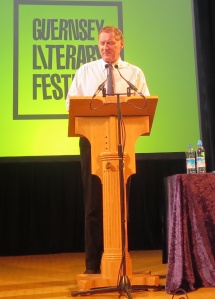

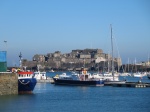
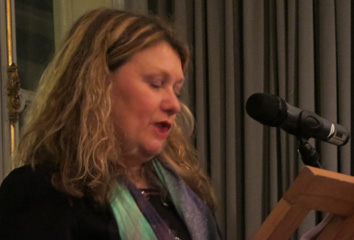

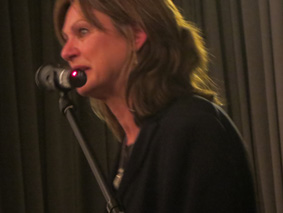








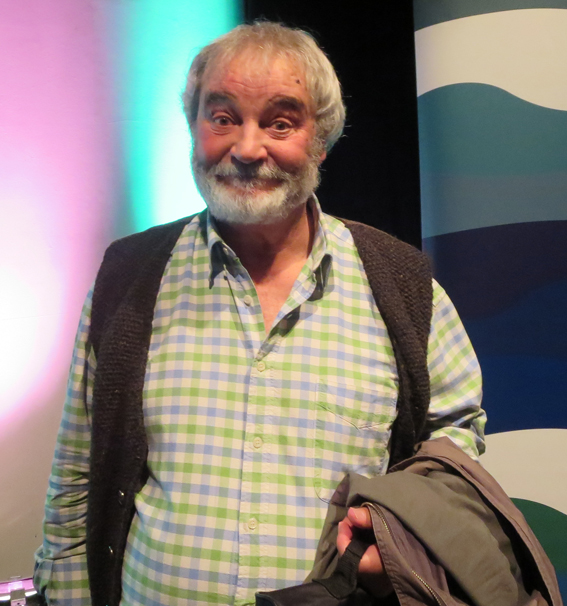
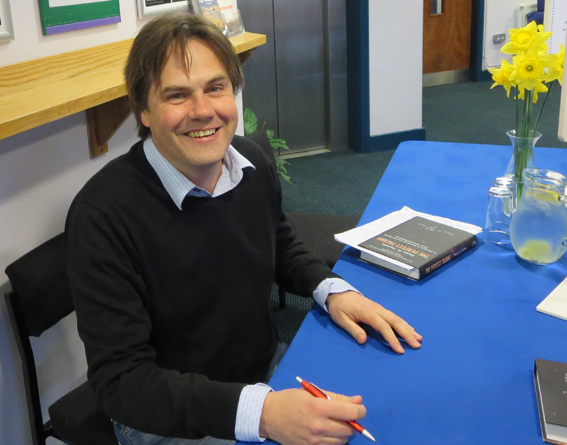









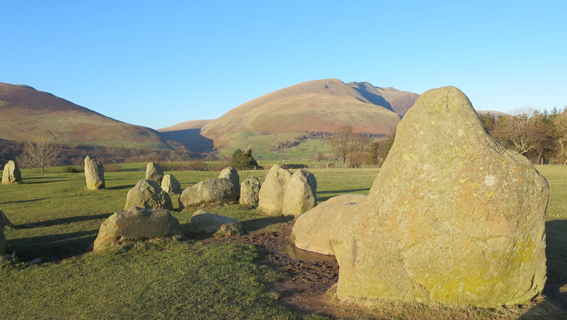




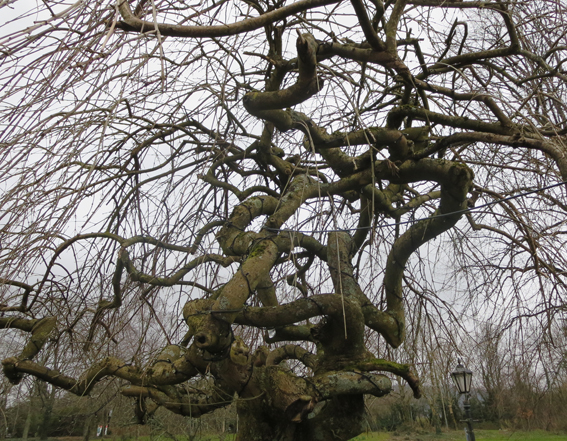



 Derwentwater. It’s a distance of a little over nine miles, but there’s a good spot for lunch half-way round where, yet again, we were able to eat outside. The terrain has been improved since the last time we trekked round the lake, so the walking was not difficult, and it was certainly a day for shorts and tee shirts. We were surrounded every minute of the day by so much beauty, both in the countryside through which we passed and also in the individual trees, flowers and lichens that we stopped to admire on the way.
Derwentwater. It’s a distance of a little over nine miles, but there’s a good spot for lunch half-way round where, yet again, we were able to eat outside. The terrain has been improved since the last time we trekked round the lake, so the walking was not difficult, and it was certainly a day for shorts and tee shirts. We were surrounded every minute of the day by so much beauty, both in the countryside through which we passed and also in the individual trees, flowers and lichens that we stopped to admire on the way.




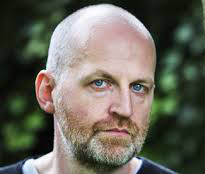







 The festival includes some short introductory presentations of half an hour, and Jolyon Mitchell gave one of these on the subject of Martyrdom, which is the title of his most recent book. The presentation was illustrated with slides of varying horror, ranging over modern martyrs right back through history. Half an hour was unsatisfactorily short for this talk, which was, of necessity, rather rushed. However, it left us with plenty of interesting questions for reflection and discussion.
The festival includes some short introductory presentations of half an hour, and Jolyon Mitchell gave one of these on the subject of Martyrdom, which is the title of his most recent book. The presentation was illustrated with slides of varying horror, ranging over modern martyrs right back through history. Half an hour was unsatisfactorily short for this talk, which was, of necessity, rather rushed. However, it left us with plenty of interesting questions for reflection and discussion.

